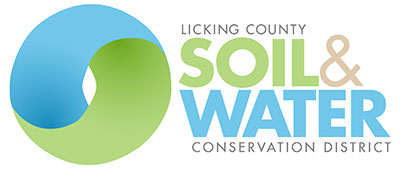Urban Tree Benefits!
Many of our Licking County residents are in urbanized areas and might not have access to large forests, however, many communities have urban trees lining their streets. Urban trees are important and provide services to city residents. The benefits we all know, like cleaner air, are great, but urban trees also provide cooler temperatures, healthier residents mentally and physically, and higher property values. Research also shows trees can reduce stormwater runoff. Stormwater runoff is traditionally managed with infrastructure piping precipitation to surface water or wastewater treatment plants. Green infrastructure efforts like rain gardens and bioswales offer alternatives that are better for environmental health. Trees in urban environments can reduce stormwater runoff by canopy capture, transpiration, and soil infiltration. Interested in benefits for your area? Check out iTree, a tool to evaluate tree benefits.
Stream Maintenance and Log Jam Removal
In Ohio, the right of maintaining clean and free-flowing waterways belongs to the property owner. The following guidelines are provided to assist property owners with stream maintenance.
One of the best steps a property owner can take to protect property from soil erosion, flooding, and water quality problems is to seed and maintain vegetation along waterways. The grass and tree roots absorb water runoff and reduce soil erosion. They also improve water quality by shading surface water and “buffering” fertilizers, pesticides, and other chemicals that could otherwise end up in the stream or groundwater. Plant grass buffers within 15 to 20 feet of stream banks and wherever topsoil is exposed. Plant trees close enough to the stream to provide shade over the stream channel, but not so close that future channel meandering may cause the trees to fall down. Do not mow to the edge of the stream. Allow tree, shrub and grass roots to stabilize stream banks.
The Licking County Flood Damage Prevention Regulations restrict the placement of topsoil, gravel, or other fill material in the floodplain. During a flooding event, material washes into the stream channel and potentially diverts and elevates floodwater. Old lumber and construction materials, yard waste, and other debris can clog culverts and bridges. To temporarily store fill material, or any other debris in the floodplain, file a required floodplain permit application with the Licking County Planning and Development Department.
The Army Corp of Engineers oversees and regulates all stream channelization projects, stream bank stabilization projects below normal pool, and filling and dredging activities. Please contact their office, as well as the Licking County Planning and Development Department, before initiating any work. Use rocks, boulders and concrete rip-rap (no asphalt or other chemically-treated road debris) for stream bank stabilization along eroding banks. When placing rip-rap in the channel, align the pieces like shingles on a rooftop. This placement redirects water to the center of the stream channel, and helps prevent further erosion of the stream bank underneath. Water is powerful, so put the largest rocks at the base of the stream bank where water velocity is the greatest. Fill voids with various sizes of smaller stone. Do not place filter fabric below the rocks. Plant live stakes (cuttings of willows and other water-loving trees/shrubs) on stream bank slope and trees on top of the slope. Minimize the amount of rip-rap used. Material placed in the floodplain displaces water and raises flood levels in the event of a major storm. While it is important to prevent stream bank erosion around bridges and roads, please be courteous to property owners downstream who may feel the effects of rising flood water. Do not alter the direction or width of present waterways. Streams are dynamic, ever-changing bodies of water. They release their gravitational energy by flowing downstream through meandering channels, pools and riffles. Straightened channels cause greater water velocities. The faster flowing water must be compensated for downstream.
When removing logs and debris from stream channels, pull the whole tree out, including root ball, if detached from the ground. On land, along the stream, cut fallen or broken tree away from its base; the stump remains in the ground to hold surrounding soil in place on land. These practices minimize soil from eroding into the stream. Keep all machinery and equipment from entering the stream channel whenever possible. This practice causes less disturbance to the stream bed and stream bank, as well as minimizes the chances a hazardous chemical (such as oil or gasoline) may leak into the water. If in-channel equipment must be used, contact the Army Corp of Engineers for approval. Also, file a required floodplain permit application with the Licking County Planning and Development Department.
Additional information:
Licking County Planning Department: www.lcounty.com/depts/planning; phone: (740) 670-5200; or email planninganddevelopment@lcounty.com
US Army Corps of Engineers, Huntington District Office - phone: (866) 502-2570; or email pa2@usace.army.mil



